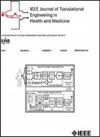MRI-Driven Longitudinal Studies of Hippocampal Alterations During the Initial Cognitive Decline
IF 4.4
3区 医学
Q2 ENGINEERING, BIOMEDICAL
IEEE Journal of Translational Engineering in Health and Medicine-Jtehm
Pub Date : 2024-12-02
DOI:10.1109/JTEHM.2024.3510429
引用次数: 0
Abstract
Based on available magnetic resonance imaging (MRI) studies, hippocampal alteration is one of the hallmarks during cognitive decline. However, the longitudinal hippocampal morphometric changes during the initial cognitive decline are unclear. Exploring a validated biomarker with high clinical relevance is urgent. This work proposed an automated MRI-driven longitudinal hippocampal alteration analysis system (LHAAS), which consists of hippocampal segmentation, reconstruction, registration, multivariate morphometric feature extraction, and longitudinal analysis of hippocampal morphometric and volumetric differences between groups. LHAAS was applied on two groups: cognitive unimpaired (CU) participants who maintained cognitive unimpaired (non-Progressors), and participants who converted to MCI during the following four years (Progressors). LHAAS can detect and visualize subtle deformations in the bilateral hippocampus of CU progressors four years before they show initial cognitive decline. For CU progressors, hippocampal atrophy initially occurs at the CA1 subregion and then along with disease progression, spreading to the CA2-3 and Subiculum subregion, exhibiting a left-greater-than-right trend. The volumetric analyses showed similar results. Besides, hippocampal subregions highly correlated with clinical measurement were identified by correlation analysis. LHAAS can accurately reflect the small hippocampal subregional atrophy at preclinical AD. This proposed system can track the longitudinal hippocampal alterations in the early stages of AD and provide insights for early intervention. Clinical and Translational Impact Statement: LHAAS offers early detection of subtle hippocampal alterations at preclinical AD. This advance enables pathological research and timely interventions to potentially improve patient outcomes in clinical implementation.最初认知衰退期间海马改变的mri驱动纵向研究
根据现有的磁共振成像(MRI)研究,海马改变是认知能力下降的标志之一。然而,在最初的认知衰退期间,海马的纵向形态变化尚不清楚。探索具有高度临床相关性的有效生物标志物是迫切需要的。本研究提出了一种mri驱动的海马纵向改变分析系统(LHAAS),该系统包括海马分割、重建、配准、多变量形态特征提取以及海马形态和体积差异纵向分析。LHAAS应用于两组:认知未受损(CU)参与者保持认知未受损(非进展者),以及在接下来的四年中转换为MCI的参与者(进展者)。LHAAS可以在CU进展者表现出初始认知能力下降的4年前检测并可视化其双侧海马体的细微变形。对于CU进展者,海马萎缩最初发生在CA1亚区,然后随着疾病进展,向CA2-3和下托亚区扩散,呈现左大于右的趋势。体积分析也显示了类似的结果。通过相关分析,发现与临床测量高度相关的海马亚区。LHAAS能准确反映阿尔茨海默病临床前海马小分区萎缩情况。该系统可以跟踪阿尔茨海默病早期海马的纵向变化,并为早期干预提供见解。临床和转化影响声明:LHAAS可以在临床前AD中早期检测到细微的海马改变。这一进展使病理研究和及时干预能够潜在地改善临床实施中的患者结果。
本文章由计算机程序翻译,如有差异,请以英文原文为准。
求助全文
约1分钟内获得全文
求助全文
来源期刊

IEEE Journal of Translational Engineering in Health and Medicine-Jtehm
Engineering-Biomedical Engineering
CiteScore
7.40
自引率
2.90%
发文量
65
审稿时长
27 weeks
期刊介绍:
The IEEE Journal of Translational Engineering in Health and Medicine is an open access product that bridges the engineering and clinical worlds, focusing on detailed descriptions of advanced technical solutions to a clinical need along with clinical results and healthcare relevance. The journal provides a platform for state-of-the-art technology directions in the interdisciplinary field of biomedical engineering, embracing engineering, life sciences and medicine. A unique aspect of the journal is its ability to foster a collaboration between physicians and engineers for presenting broad and compelling real world technological and engineering solutions that can be implemented in the interest of improving quality of patient care and treatment outcomes, thereby reducing costs and improving efficiency. The journal provides an active forum for clinical research and relevant state-of the-art technology for members of all the IEEE societies that have an interest in biomedical engineering as well as reaching out directly to physicians and the medical community through the American Medical Association (AMA) and other clinical societies. The scope of the journal includes, but is not limited, to topics on: Medical devices, healthcare delivery systems, global healthcare initiatives, and ICT based services; Technological relevance to healthcare cost reduction; Technology affecting healthcare management, decision-making, and policy; Advanced technical work that is applied to solving specific clinical needs.
 求助内容:
求助内容: 应助结果提醒方式:
应助结果提醒方式:


